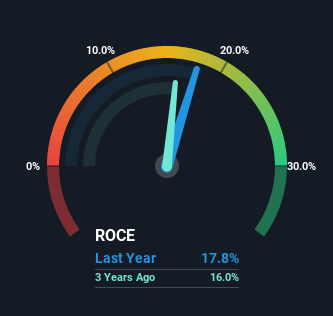We Like These Underlying Return On Capital Trends At KDDL (NSE:KDDL)
If we want to find a potential multi-bagger, often there are underlying trends that can provide clues. In a perfect world, we'd like to see a company investing more capital into its business and ideally the returns earned from that capital are also increasing. Basically this means that a company has profitable initiatives that it can continue to reinvest in, which is a trait of a compounding machine. With that in mind, we've noticed some promising trends at KDDL (NSE:KDDL) so let's look a bit deeper.
Return On Capital Employed (ROCE): What Is It?
Just to clarify if you're unsure, ROCE is a metric for evaluating how much pre-tax income (in percentage terms) a company earns on the capital invested in its business. The formula for this calculation on KDDL is:
Return on Capital Employed = Earnings Before Interest and Tax (EBIT) ÷ (Total Assets - Current Liabilities)
0.18 = ₹857m ÷ (₹7.4b - ₹2.6b) (Based on the trailing twelve months to June 2022).
Thus, KDDL has an ROCE of 18%. In absolute terms, that's a satisfactory return, but compared to the Luxury industry average of 14% it's much better.
View our latest analysis for KDDL

While the past is not representative of the future, it can be helpful to know how a company has performed historically, which is why we have this chart above. If you'd like to look at how KDDL has performed in the past in other metrics, you can view this free graph of past earnings, revenue and cash flow.
How Are Returns Trending?
KDDL is displaying some positive trends. The data shows that returns on capital have increased substantially over the last five years to 18%. The company is effectively making more money per dollar of capital used, and it's worth noting that the amount of capital has increased too, by 158%. The increasing returns on a growing amount of capital is common amongst multi-baggers and that's why we're impressed.
In another part of our analysis, we noticed that the company's ratio of current liabilities to total assets decreased to 35%, which broadly means the business is relying less on its suppliers or short-term creditors to fund its operations. This tells us that KDDL has grown its returns without a reliance on increasing their current liabilities, which we're very happy with.
The Bottom Line
All in all, it's terrific to see that KDDL is reaping the rewards from prior investments and is growing its capital base. And with the stock having performed exceptionally well over the last five years, these patterns are being accounted for by investors. In light of that, we think it's worth looking further into this stock because if KDDL can keep these trends up, it could have a bright future ahead.
If you want to know some of the risks facing KDDL we've found 2 warning signs (1 shouldn't be ignored!) that you should be aware of before investing here.
If you want to search for solid companies with great earnings, check out this free list of companies with good balance sheets and impressive returns on equity.
Valuation is complex, but we're here to simplify it.
Discover if KDDL might be undervalued or overvalued with our detailed analysis, featuring fair value estimates, potential risks, dividends, insider trades, and its financial condition.
Access Free AnalysisHave feedback on this article? Concerned about the content? Get in touch with us directly. Alternatively, email editorial-team (at) simplywallst.com.
This article by Simply Wall St is general in nature. We provide commentary based on historical data and analyst forecasts only using an unbiased methodology and our articles are not intended to be financial advice. It does not constitute a recommendation to buy or sell any stock, and does not take account of your objectives, or your financial situation. We aim to bring you long-term focused analysis driven by fundamental data. Note that our analysis may not factor in the latest price-sensitive company announcements or qualitative material. Simply Wall St has no position in any stocks mentioned.
About NSEI:KDDL
KDDL
Engages in the manufacturing and sale of watch dials and hands, precision engineering components, and press tools in India, Switzerland, Germany, the United Kingdom, the United States, France, Portugal, the Czech Republic, China, and internationally.
Excellent balance sheet with reasonable growth potential.
Similar Companies
Market Insights
Community Narratives




